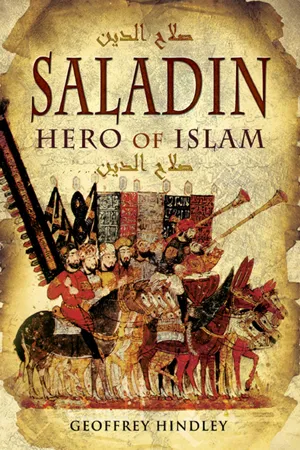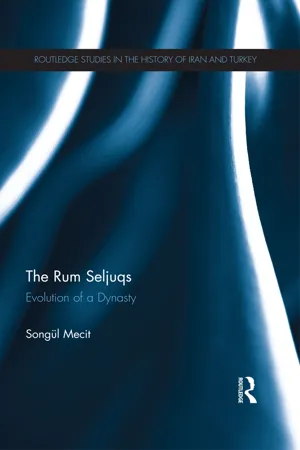History
Nur al-Din
Nur al-Din, also known as Nur ad-Din Zangi, was a prominent ruler of the Zengid dynasty in the 12th century. He is remembered for his efforts to unite the Muslim territories against the Crusaders and for his role in the reconquest of Edessa. Nur al-Din's reign was marked by his military prowess, religious piety, and efforts to establish a unified Islamic state.
Written by Perlego with AI-assistance
6 Key excerpts on "Nur al-Din"
Learn about this page
Index pages curate the most relevant extracts from our library of academic textbooks. They’ve been created using an in-house natural language model (NLM), each adding context and meaning to key research topics.
- eBook - ePub
The Crusades
The War for the Holy Land
- Thomas Asbridge(Author)
- 2012(Publication Date)
- Simon & Schuster UK(Publisher)
9With Joscelin captive, his wife Beatrice sold off the remainder of the Latin county to the Byzantines, prompting a stream of Frankish and eastern Christian refugees to flee to Antioch. The countess settled in Palestine, where her children – Joscelin III and Agnes – later became prominent political figures. Even the Greeks proved unable to defend these isolated outposts and, with the fall of Tell Bashir to Nur al-Din’s forces in 1151, the county of Edessa came to a final, irredeemable end. The Zangids had eradicated one of the four crusader states.Passage contains an image 8 THE LIGHT OF FAITH
Nur al-Din emerged as the Near East’s foremost Muslim leader in the aftermath of the Second Crusade. Over the course of his career, Nur al-Din would unite Syria, extend Zangid power into Egypt and score a series of victories against the Christian Franks. He became one of the greatest luminaries of medieval Islam, celebrated as a stalwart of Sunni orthodoxy and a champion of jihad against Latin Outremer. Indeed, the appellation by which he is known to history, ‘Nur al-Din’, literally means ‘the Light of Faith’.Muslim chroniclers of the age generally presented Nur al-Din as the very archetype of a perfect Islamic ruler – deeply pious, clement and just; humble and austere, yet cultured; valiant and skilful in battle, and committed to the war for the Holy Land. This view was most powerfully expressed by the great Iraqi historian Ibn al-Athir (d. 1233), writing in Mosul in the early thirteenth century, when that city was still governed by members of Nur al-Din’s Zangid dynasty. Among his many works, Ibn al-Athir composed a voluminous account of human history, starting with the Creation, and even in this chronicle Nur al-Din was presented as the principal protagonist. ‘The fame of his good rule and justice’ was said to have ‘encompassed the world’, and ‘his good qualities were numerous and his virtues abundant, more than this book can contain’.10 - eBook - ePub
- H.A.R. Gibb(Author)
- 2013(Publication Date)
- Routledge(Publisher)
public life; and it would be a gratuitous assumption, in the face of such evidence, that, inasmuch as these measures served the political interests of Nur ad-Din, they were not motivated by sincere personal attachment to their objects and ideals.There are, however, some essential differences between the circumstances in which Nur ad-Din and Saladin carried out their tasks. Nur ad-Din operated from within the structure of politics of his age. Since the break-up of the Seljuk sultanate at the end of the eleventh century, Western Asia had been parceled out amongst a number of local dynasties, all of them (except a few remote baronies) founded by Turkish generals or Turcoman chiefs, and all of them characterized by two common features. One was the spirit of personal advantage and aggrandizement which determined their political actions and relationships. It seems well-nigh impossible to discover in the relations of the Turkish princes or the Turcoman chiefs with one another—even when they were members of the same family—any sense of loyalty or restraint in exploiting each other's weaknesses, let alone that solidarity shown, for example, by the Buwaihid brothers in Persia in the tenth century. The tale of plots, revolts, ephemeral alliances, treacheries, calculated perfidies, dethronements during the twelfth century is unending. In the general political demoralization even the most resolute and unscrupulous princes, a Zangi or a Takash, could scarcely keep their feet.The other was the composition of their military forces. The foundation of each prince's power was a standing regiment of guards or askar of Turkish mamluks, consisting of Turkish slaves purchased in boyhood and trained as professional cavalrymen, freed in due course, and maintained by the grant of military fiefs, from which they drew their revenues in money and kind. The continual warfare between the principalities was carried on by these professional troops, whose intensely personal loyalty was given to their immediate commander, and who therefore followed him into rebellion or changes of allegiance with little regard to the interests of their prince. Being professional armies, they were expensive to maintain and therefore small in numbers; one of the reasons for the constant efforts of princes to seize their neighbors' territories was precisely in order to gain the means of enlarging their forces. Furthermore, they could not and would not remain on campaign longer than a certain period at a time; on the one hand, the prince could not afford a high rate of wastage, and on the other the troops themselves, as soon as their period of campaign service (called in Arabic baikar) was over, had no thought but to return to enjoy the proceeds of their fiefs.4 The Turcoman troops, though nomadic irregulars, were little different; they too went on campaign only for a limited time, for so long as they could subsist on plunder or were paid for their services in money and supplies.5 - eBook - ePub
- P.M. Holt(Author)
- 2016(Publication Date)
- Routledge(Publisher)
chapter four Nūr Al-Dīn, Saladin and the Frankish StatesThe reign of Nūr al-Dīn and the acquisition of Damascus
During his long reign from 1146 to his death in 1174, Nūr al-Dīn outlived all those who were his fellow rulers at his accession. In particular, his elder brother Ghāzī I, the atabeg of Mosul, died in November 1149, and thereby Nūr al-Dīn became the head of the Zangid clan. Ghāzī was succeeded by his son, Quṭtb al-Dīn Mawdūd, and he by his son, Ghāzī II, in 1170. The history of Mosul was almost entirely distinct in this period from that of Nūr al-Dīn's possessions.From the start Nūr al-Dīn was involved in dealings with the Frankish states on his borders. Apart from establishing his control over Edessa, and ultimately over the whole of the former county after Joscelin II's death as his prisoner in 1150, his first intervention was over a curious episode in 1148 in the county of Tripoli. Raymond II, the reigning count, was challenged by a pretender who had ensconced himself in the stronghold of 'Urayma, an important strategic site dominating the coastal route near Latakia. Raymond called on Unur of Damascus for help, and then invited the cooperation of Nūr al-Dīn. Their success was complete, and the stronghold was demolished. The incident shows the Muslim powers in an unusual light as the chosen arbitrators in a purely Frankish concern, a reflection of their enhanced status after the Second Crusade.Nūr al-Dīn's second involvement with the Franks came when he was asked by the reigning Seljuk sultan, Mas'ūd, to intervene against Raymond of Antioch, who was raiding beyond the northern borders of his principality to the east of the Amanus mountains. The expedition was disastrous. Nūr al-Dīn was taken by surprise in his camp in November 1148, and was forced to flee to Aleppo. In the following year he took his revenge. In the summer of 1149 he planned to take Afāmiya on the middle Orontes, which had been captured by Tancred in 1106, and he called on Unur to provide a supporting contingent. Unur safeguarded himself by a two-year truce with Baldwin III in Muḥarram 544/May-June 1149, and then sent the required force. It was a second Field of Blood. Raymond was defeated and killed in the battle. Afāmiya was taken in July and Andoch itself besieged. In the meantime King Baldwin III brought in a relieving army and negotiated peace with Nūr al-Dīn. Apart from Afāmiya, Nūr al-Dīn failed at this time to advance his frontier to the Orontes. The stronghold of Hārim to the north was also taken, although not yet permanently held. It was to mark the effective frontier between Aleppo on the east and the Franks on the west. Antioch meanwhile remained, at least in name, under the rule of the Princess Constance, Raymond's widow. - eBook - ePub
The Crusades
A Beginner's Guide
- Andrew Jotischky(Author)
- 2015(Publication Date)
- Oneworld Publications(Publisher)
In 1171, on Nur’s orders and after the death of the unfortunate al-‘Adid, the Fatimid caliphate was suppressed. Shi‘ite rule in Egypt, after two hundred years, was over and one of the aims of Nur’s jihad – the extension of Sunni orthodoxy – had been furthered significantly. But Nur proved unable to control his protégé, who had adopted the Seljuq title of sultan in Egypt. By 1174, Nur was ready to call Saladin to account for his governance in Egypt when he died following a short illness after a game of polo. The way was clear for Saladin to assume full control in Egypt, but the Kurd was not content with that. He realized that despite the widespread authority Nur had commanded throughout Syria, his dynastic hold was precarious. His heir, as-Salih, was only eleven years old; one nephew, Saif ad-Din, who controlled Mosul, began openly to flout Nur’s example of pious rulership by riotous living; his other nephew, ‘Imad ad-Din Zengi, barely clung to power in Sinjar. Saladin used the pretext of an anticipated Frankish invasion of Damascus to march a small army to Syria himself. He was doubly fortunate: the Syrian emirs who wanted to control as-Salih were divided among themselves, and in July 1174 King Amalric died, leaving an uncertain succession in Jerusalem. Saladin’s prompt action caught prospective opponents in Damascus on the back foot, and he was invited to take control of the city on behalf of as-Salih. At least one Arab chronicler later wrote that he had bought off opposition with handsome payments, and William of Tyre, a canny observer from Jerusalem, remarked that one of the things that made Saladin so dangerous was his generosity. As-Salih was whisked off to Aleppo by emirs loyal to the Zengid dynasty, and it was from Aleppo that the only challenge to what was obviously a coup d’état came. Qutb ad-Din, one of Nur’s emirs, sent the message that the swords that had given Saladin Egypt would drive him back there - eBook - ePub
Saladin
Hero of Islam
- Geoffrey Hindley(Author)
- 2007(Publication Date)
- Pen & Sword Military(Publisher)
Good Muslims themselves, both men wanted to see the extirpation of the Franks; as strategists they fully recognised the threat that could come from their beach-head kingdom and its principalities. But as hard-headed politicians they also recognised that the enemy, perennially short of men and funds, at odds with the native population, repetitively quarrelling amongst themselves, and with their wealthy ports controlled by Italians who would as lief deal with Muslims as Christians for profit, was the least of their worries. While Syrian power continued in full and confident spate, the Christians seemed almost a side-show contingent, to be contained on the defensive and dealt with at leisure.The French scholar Emanuel Sivan develops the convincing thesis that Nur-ad-Din encouraged the preaching of the jihad as a tool of propaganda. The aim was to force unity on Syria, Iraq and then Egypt, so that their massive resources could be combined against the Unbelievers. But there were to be emirs and others who learnt that this military evangelism could be used equally well to subvert their authority over their own subjects who might be urged to transfer allegiance to Nur-ad-Din in the common effort against the Christians.The revival of jihad teachings began in the work of isolated pietists and enthusiastic scholars and the leaders of the orthodox religious establishment had little interest in it at first. They were more concerned with the struggle against heresy and the triumph of Sunni Islam. But the twelfth century also saw a notable revival in popular religious feeling and it was this which, harnessed to the idea of the jihad by Nur-ad-Din and his propagandists, changed an esoteric enthusiasm into a popular mass movement.An important factor in Nur-ad-Din’s success was his personal religiosity. His enemy, Kilij Arslan of Konya, accused him of hypocrisy, though he could not fault his meticulous observance of the faith. Even at this distance in time one is willing to refute the charge of hypocrisy and to accept as something more than flattery the words of a courtier that ‘he led a double jihad - eBook - ePub
The Rum Seljuqs
Evolution of a Dynasty
- Songul Mecit(Author)
- 2013(Publication Date)
- Routledge(Publisher)
47Kı lı ç Arslan II and Nū r al-Dī nKı lı ç Arslan’s accession was accompanied by the usual Seljuq succession struggle but he had been appointed by his father as he was obviously the strongest candidate and ruthlessly wiped out the internal opposition immediately. He could, however, not easily rid himself of the external opposition of the Dā nishmendid ruler Yağ ı basan and his supporter Nū r al-Dī n. Both these rulers regarded the prospect of a strong Seljuq ruler in Anatolia as a threat to their power. Kı lı ç Arslan’s objective in bringing all Turkish-held Anatolian territories under his control threatened the very existence of the Dā nishmendid polity. On the other hand, it would inevitably lead to a clash with Nū r al-Dī n who aimed to bring the Syrian territories under his control.48 Hence the northern Syrian territories were disputed territories between Kı lı ç Arslan and Nū r al-Dī n alike and the Euphrates became the natural frontier between the two powers.When Kı lı ç Arslan acceded to the throne, Nū r al-Dī n had already been in office for a decade. He had established his power over most of Syria and now possessed great military strength. More importantly, Nū r al-Dī n had extended the propaganda machine founded under his father and he claimed to be the real champion of Islam and warrior for the faith, despite the fact that he had up to then mainly directed his military activities against fellow-Muslims, and not the Franks or Byzantines. He justified his actions against fellow-Muslims by claiming that he had to force union on the unwilling princes of Syria for the jihad against the Franks. The main objective for both sides seems to have been to secure their power over Muslim territories, Kı lı ç Arslan in Anatolia and Nū r al-Dī n in Syria. Thus they used every opportunity to interfere in the affairs of the other in order to expand their territories and to extend their sphere of influence. Each side was even prepared to ally with Christians against the other. Nū r al-Dī n renewed his treaty with the Crusader state of Jerusalem and concluded another with Antioch to have a free hand and to make use of the dispute between Kı lı ç Arslan and Yağ ı basan. Under the pretext of protecting the latter against the former he invaded Seljuq territories in eastern Anatolia and northern Syria. The Syrian chronicler Ibn al-Qalā nisī reports the clash between Kı lı ç Arslan and Nū r al-Dī





